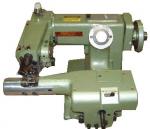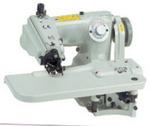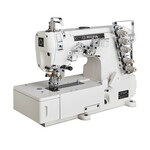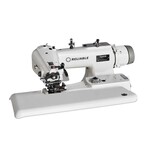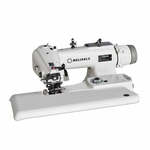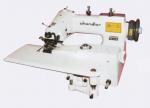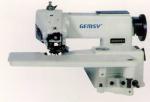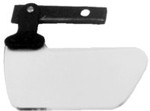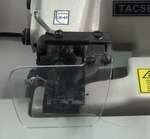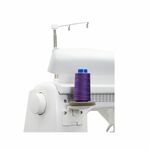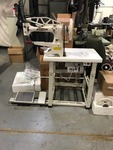Blind Hem Stitch Hemmer with Power Stand, for Invisible Seams on Apparel and/or Drapery Fabrics, but Not Upholstery |
(Q) What type thread is used with this machine? Would thinner serger thread be ok?
(A) Yes, MaxiLock single strand polyester serger thread is fine. You can also use 100% nylon thread if it has some texture, as opposed to clear nylon (like fishline) which is more abrasive to metal parts. John
Janie, we couldn't find a very good image of an industrial machine curved-needle blindhem stitch online. It is a chainstitch with serger type stitch covering the hem/fold on the inside, and very little if any of the stitch or pull showing through on the right side. Most of the thread shows on the inside hem with very little showing on the outside. It is supposed to be invisible on the outside which is very difficult to do on very lightweight fabrics, unless you use the same color thread as the garment fabric. So the two sides are not supposed to look the same, like a zigzag stitch would on a sewing machine. We recommend portable blindstitch machines for garments, and power stand models for drapery or for faster speed on garments. Hope this information helps. John
(Q)When I pull the stitching out, several stitches unravel along with it. Is there a way to tack the stitches to prevent unraveling?
(A)Jenna, there are several ways of securing a blind hem stitch at the end of a seam. The easiest way is to sew over and beyond the end of a seam, especially if hemming a tubular item like pants. When you sew over previous stitching it helps to lock the stitches in.
Before you remove fabric from the end of the machine feeder, turn the hand wheel clockwise to swing the needle all the way to the left position in the needle channel which will help secure the thread and stitch in place. Then quickly pull or jerk the fabric hem from behind the feeder which will break the thread and tie off the chain stitch so that it will not continue to unravel. It takes some practice because you may have to use the knee lever or hand wheel to position or release the fabric if it is not already at the end of the feeder.
You can also turn the hand wheel counterclockwise at the end of the seam (like reverse stitching but no formation) just to hide the end stitches, or you can manually weave the unraveled thread back into the chainstitch with a seaming needle.


